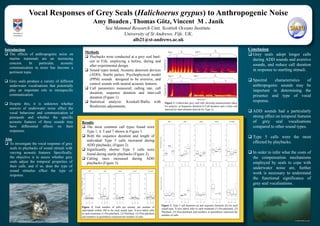More Related Content
Similar to Amy Boaden_Poster Final
Similar to Amy Boaden_Poster Final (20)
Amy Boaden_Poster Final
- 1. Vocal Responses of Grey Seals (Halichoerus grypus) to Anthropogenic Noise
Amy Boaden , Thomas Götz, Vincent M . Janik
Sea Mammal Research Unit, Scottish Oceans Institute.
University of St Andrews, Fife. UK.
alb21@st-andrews.ac.uk
Introduction
The effects of anthropogenic noise on
marine mammals are an increasing
concern. In particular, acoustic
communication in noise has become a
pertinent topic.
Grey seals produce a variety of different
underwater vocalisations that potentially
play an important role in intraspecific
communication.
Despite this, it is unknown whether
sources of underwater noise effect the
vocal behaviour and communication of
pinnipeds and whether the specific
acoustic features of these sounds may
have differential effects on their
responses.
Aim
To investigate the vocal response of grey
seals to playbacks of sound stimuli with
varying acoustic features. Specifically,
the objective is to assess whether grey
seals adjust the temporal properties of
their calls, and if so, does the type of
sound stimulus effect the type of
response.
Conclusion
Grey seals adopt longer calls
during ADD sounds and aversive
sounds, and reduce call duration
in response to startling stimuli.
Spectral characteristics of
anthropogenic sounds may be
important in determining the
presence and type of vocal
response.
ADD sounds had a particularly
strong effect on temporal features
of grey seal vocalisations
compared to other sound types.
Type 5 calls were the most
effected by playbacks.
In order to infer what the costs of
the compensation mechanisms
employed by seals to cope with
underwater noise are, further
work is necessary to understand
the functional significance of
grey seal vocalisations.
Figure 1. Underwater grey seal calls showing measurements taken
for analysis. a) Sequence duration b) Call duration and c) Inter-call
interval (or inter-element interval for Type 1).
Methods
Playbacks were conducted at a grey seal haul-
out in Fife, employing a before, during and
after experimental design.
Sound types tested; Acoustic deterrent devices
(ADD), Startle pulses, Psychophysical model
(PPM) sounds designed to be aversive, and
control sounds with neutral acoustic features.
Call parameters measured; calling rate, call
duration, sequence duration and inter-call
duration (Figure 1).
Statistical analysis: Kruskall-Wallis with
Bonferroni adjustments.
Results
The most common call types found were
Type 1, 4, 5 and 7 shown in Figure 1.
Both the sequence duration and length of
individual Type 5 calls increased during
ADD playbacks, (Figure 2).
Significantly shorter Type 5 calls were
found during startle playbacks (Figure 2).
Calling rates increased during ADD
playbacks (Figure 3).
Figure 3. Total number of calls per minute, per number of
individuals within 100 m for each sound type. X-axis labels refer
to each treatment (1) Pre-playback, (2) Playback, (3) Post-playback
and numbers in parenthesis represent the number of calls
Figure 2. Type 5 call duration (a) and sequence duration (b) for each
sound type. X-axis labels refer to each treatment (1) Pre-playback, (2)
Playback, (3) Post-playback and numbers in parenthesis represent the
number of calls.
Grey seal © ORES Ursula Tscherter
